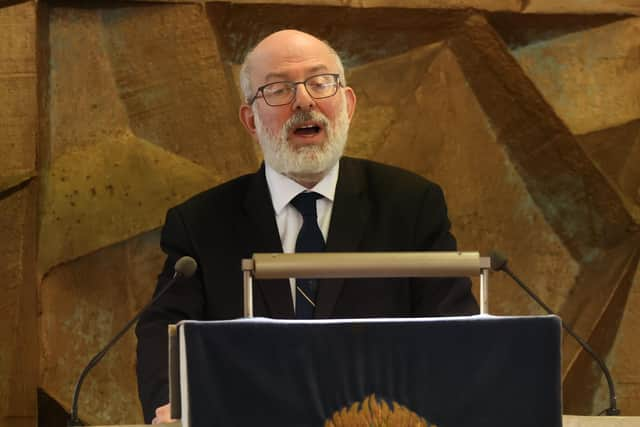Dean Godson: Ruthless IRA murder of Edgar Graham 40 years ago deprived unionism of a great intellectual mind and a future leader


So said Eoghan Harris, the long-time chief ideologue of the Workers’ Party and later a prominent scriptwriter, journalist and political consultant.
The assassination on 7 December 1983 of the Ulster Unionist assemblyman Edgar Graham at Queen’s University Belfast – where he worked as an inspiring law lecturer – remains one of the best-known killings of the Troubles. To this day, he continues to be remembered as the “lost leader of unionism”.
Advertisement
Hide AdAdvertisement
Hide AdGraham lives on in the memories of many because he was the highest quality of targets – and because of the personal tragedy of a career of such promise being brutally cut short with such malignant aforethought.


There was also a class dimension to his killing: the Troubles mostly affected working class communities on both sides of the communal divide, often on polarised interfaces. By contrast, this was a very middle-class murder born of ideological as well as sectarian hatred.
The unionist middle classes, of which Graham was a part, were relatively unscathed by the Troubles. One reason for this was that after the Troubles began, many “Big House” and middle class unionists opted out of politics.
Graham, along with his fellow Queen’s law lecturer, David Trimble, were amongst the comparatively few unionists from the professional classes who stepped up to the plate in terms of political service (service in the security forces was another matter).
Advertisement
Hide AdAdvertisement
Hide AdAlong with Trimble, he was one of the handful of unionist political intellectuals. Both men’s undoubted gifts brought them to the attention of the IRA; but their abilities also made them the object of suspicion amongst their fellow unionists.
Jim Molyneaux, the long time UUP leader from 1979-95 and who lacked any tertiary education, made no bones to me about not liking both men -- whom he regarded as unworldly and overly bookish. Molyneaux was thus typical of a kind of Troubles-era unionist ,who prized “good-guydom” of the loyal orders over real ability.
But it was also a middle-class murder on the perpetrators’ side, too. Many of the key players on the republican side in setting Graham up were not trapped in working class Catholic ghettoes - but were studying or working at Queen’s University Belfast.
As such, they came either from the established nationalist bourgeoisie or were well on the way to becoming part of that bourgeoise, thanks to the opportunities for upward mobility that the post-War British social democratic state provided for all citizens of Northern Ireland - via the provision of the greatly expanded higher education sector (an expansion which was to become bigger still).
Advertisement
Hide AdAdvertisement
Hide AdSo who was Edgar Graham? And what were the circumstances of his death? He was born in 1954, came from Randalstown, Co. Antrim, and had attended Ballymena Academy. After Queen’s, he had gone on to postgraduate work at Trinity College, Oxford, where he worked on a thesis on sovereign immunity, and his friends and contemporaries included Andrew Tyrie (now Lord Tyrie).
Returning from England, he was called to the Bar and taught public law at Queen’s. He and Trimble occupied adjacent offices and became close professionally and politically, talking animatedly together in the common room during coffee breaks.
See also:
Advertisement
Hide AdAdvertisement
Hide AdGraham, who had been interested in politics since his teens, joined the UUP, but did not join the loyal orders: he wanted to see how far he could progress in the party without such feathers in his unionist cap. He was also opposed to capital punishment. After his election in 1982 to the Prior assembly, he displayed an impressive command of parliamentary procedure, which few could match.
In a memorable debate at the Queen’s University student union, he had conducted a brilliant defence of the so-called “supergrass” trials (to which he always referred as “turning Queen’s evidence”), drawing attention to their effectiveness in Italy in combating the Red Brigades. The supergrass system was then threatening to play havoc inside the terrorist organisations on both sides. Undoing it became one of the principal short-term aims of republicans – and Graham was a highly articulate and plausible obstacle.
Graham’s colleague, Sylvia Hermon – later to become Ulster Unionist and then independent MP for North Down – came to the debate to support him. But she had never before witnessed such hostility from some of the students. “I felt afraid for him that day and in that environment,” she remembered. “But I then did not realise the significance of it.”
However, Graham had not only come to the attention of republicans. He had also angered the loyalist terrorists, opposing separation of prisoners in the Maze. Indeed, friends of Graham – including Trimble – recall that at this point, he was more afraid of assassination by loyalists than by anyone else and he alluded to this threat in an assembly debate.
Advertisement
Hide AdAdvertisement
Hide AdPossibly, this was because Graham knew that a leading loyalist had been warned by a prison officer that he (the prison officer) overheard a UVF prisoner suggesting that Graham might be a “legitimate target” because of his policies (the implication being that if the IRA killed Graham, there would be no reciprocal strike against a nationalist). Certainly, Graham was regularly attacked in Combat – the “journal” of the UVF – during this period and especially for his views on prisoner issues.
A few months later, Sylvia Hermon walked into the law faculty building at 19 University Square to find two men she had never seen before looking at the examination timetable. She let them depart the building, but followed behind into Botanic Avenue. She ran into an RUC officer who intercepted the pair. When pressed, one of them said that he had been looking at the timetable for his sister, who was reading geography and law – a non-existent combined course. It sounded suspicious, but the policeman could do nothing.
On the last day of tutorials – 7 December 1983 – Graham walked across from the main university building to the law faculty. There, he met a colleague, Dermott Nesbitt, a lecturer in accounting and finance and later also a prominent UUP politician.
Graham laid down his case on the pavement and told Nesbitt that he was going over to London the next day to talk to the Conservative backbench Northern Ireland Committee. “John Biggs-Davison [vice chairman of the committee] is a good integrationist,” said Nesbitt, teasing his devolutionist colleague. “Michael Mates [secretary to the committee] is a good devolutionist,” retorted Graham to his integrationist colleague.
Advertisement
Hide AdAdvertisement
Hide AdAt that point, two men ran up behind Graham and fired a number of times, at point-blank range, into his head. He fell immediately to the ground – dead, aged 29. The other plotters, who did not pull the trigger, began running in all directions to distract witnesses so as to prevent the identification of the killers. Stunned, Nesbitt looked up at the row of buildings opposite. “Everyone was staring out of the windows,” remembers Nesbitt. “With all the lights on during this dark December day, the hundreds of match stalk heads looked like something out of an L S Lowry picture.”
Sylvia Hermon was present in the students’ union when his death was announced over the Tannoy: it elicited a vast roar of approval from some of the republican students. She has never been able to set foot in the place since.
That roar encapsulated the late Maurice Hayes’s much later observation – “a middle class bigot is infinitely worse than a working class bigot.”
Hitherto, Queen’s had prided itself on being “above the conflict” – a kind of safe haven where such unpleasantnesses did not intrude. Now, however, they found that the RUC investigation centred on republican students. According to the authoritative reference work, Lost Lives, two former students were given suspended sentences for withholding information about the shooting – tariffs which unionists denounced as “shameful”.
Advertisement
Hide AdAdvertisement
Hide AdBut Queen’s was terrified at the prospect of the university being torn apart by the murder. The handling of the aftermath of the killing was therefore a matter of great sensitivity – and Sir Colin Campbell, the pro-vice chancellor, declined to say what measures he took in dealing with any member of the university.
In the eyes of many of Graham’s friends, Queen’s had stuck its institutional head into the sand. The statement issued by the vice-chancellor’s office, reported in the Belfast Telegraph on 8 December 1983, read: “[No]…evidence been offered to suggest that these attacks originated from within the university and this university has no knowledge of any direct involvement by any member of staff or student.” Piously, it concluded: “The university does not impose – nor could it impose – any political test for entry as a student or appointment to the teaching staff, taking academic achievement as its only criterion.” Sir Colin Campbell described the murder as “not a political event, but primarily a human tragedy”.
Whatever controversies attended the conduct of Queen’s, one thing is certain: anyone who attended Graham’s funeral still describes it as one of the saddest days they can ever recall. Rev. Dr Alan McAloney, who had baptised Graham, conducted a packed service at Randalstown Old Congregation Presbyterian Church, which included the teacher who taught him his first lessons and the seven members of the Graham family who sang in the church choir. The cortège then moved to Duneane Presbyterian Church, one mile from the shores of Lough Neagh, where this only son was laid to rest close to his mother’s forebears.
Expressions of shock and sympathy came from all over the world: Margaret Thatcher, who had met Graham earlier in the year when he spoke at the Conservative party conference, wrote to his parents to express her condolences.
Advertisement
Hide AdAdvertisement
Hide AdBut whatever the condemnation, the killing had a profound and beneficial effect from the IRA’s viewpoint. As one close colleague has noted, Graham could have been assassinated anywhere, but the choice of Queen’s was quite deliberate. Trimble observes that “the murder reinforced the ‘chill factor’ on campus. It reinforced the tendency of Protestant children to go elsewhere for their education”. Indeed, when Nesbitt returned to teach the following term, he found on one occasion a mugshot of himself on the blackboard with a drawing pin through his head.
The gunmen are still at large today, and their identity is widely known. Even in the wildly unlikely event that they admitted their involvement, the semi-amnesty provisions of the Belfast Agreement would ensure that any sentence served would be minimal.
Trimble was unable to forget his fallen colleague and extolled his memory when he won the UUP leadership at the Ulster Hall in September 1995 and in a key vote of the Ulster Unionist Council of November 1999 to enter government with Sinn Fein for the first time. So, too, did opponents of the Belfast Agreement: “What would Edgar have done?” became a topic of intense debate between the two sides of the UUP - pro- and anti -Agreement alike.
The memorial stone to Graham remains on the wall at the entrance of the debating chamber at Stormont. The inscription, with its quote from Euripides, was specially chosen by Anne Graham, his sister:
IN MEMORY OF
EDGAR SAMUEL
DAVID GRAHAM
ASSEMBLY MEMBER FOR BELFAST SOUTH 1982–83
SHOT BYTERRORISTS ON7 DECEMBER 1983
‘KEEP ALIVE THE LIGHT OF JUSTICE’
Advertisement
Hide AdAdvertisement
Hide AdThe above essay - which was published earlier this week on the Conservative Home website (https://conservativehome.com) - is an adaptation of the chapter on Edgar Graham’s assassination from Lord Godson’s “Himself Alone: David Trimble and the Ordeal of Unionism” (HarperCollins, 2004). Lord Godson is director of Policy Exchange and a member of the Lords Subcommittee on the Windsor Framework